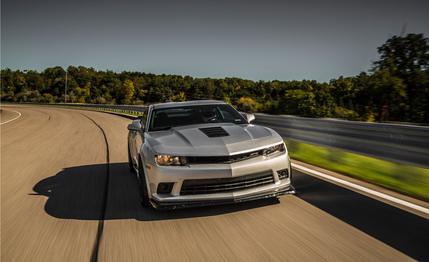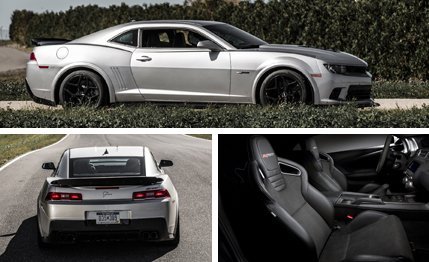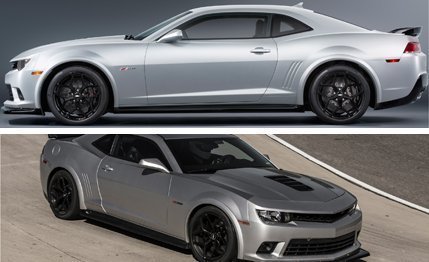
 First Ride
First Ride
Like many of us, the Camaro entered its fourth decade carrying a little extra baggage. Thick in the haunches and laden with the obligatory accouterments of the modern automotive era, Chevrolet still managed to squeeze mind-blowing performance from it, namely in the form of the Camaro ZL1, a car that goes, stops, and turns better than any 4120-pound, 580-hp car has a right to. But for Al Oppenheiser, chief engineer of the Camaro program, that was just a warm-up. The next step in the shape-up plan was the Camaro SS 1LE, a lighter, tighter, track-tuned car, followed by the surprise appearance of the even more track-focused Z/28 at the New York auto show. Clearly, Mr. Oppenheiser is not only a man with a plan but also has the friends in high places to make it happen. To give us a taste of its most recent and lightest-weight efforts, Chevrolet invited us out to GM’s Milford Road Course to provide some ballast for a cadre of hot shoes for a Nürburgring-worthy workout in a trio of Z/28s.
Hang Tight
Moments into the first hot lap, it becomes apparent that grip was high on the list of the Z/28 team’s objectives. Halfway into the deeply dished turn affectionately known as “Pahrump 2” we’re pulling more than 1.00 g, and the chassis remains rock solid. Not only a test of the suspension, this corner was intentionally designed to starve engines of oil, a job it fails at miserably with the Z/28. While the driver and passenger strain to keep the horizon in their sights, the Z’s dry-sump system—the first ever in a production Camaro—remains unfazed, supplying the rotating assemblies of the 7.0-liter engine with a steady stream of motor oil.


Speaking of the engine, it’s no secret the LS7 was chosen because it’s 64 pounds lighter than the LSA found in the ZL1. Producing 505 horsepower and 481 lb-ft of torque (10 more than it makes in the Corvette), its internals read like a who’s who of horsepower weekly: Mahle pistons, a K&N air intake, and Pankl titanium connecting rods. Oppenheiser says the connecting rods survived a 50-hour torture test running at redline with little to no wear. Z/28-specific exhaust headers are fitted, funneling into a 3.0-inch exhaust that tapers 2.75 inches at the rear. Engine oil is cooled by the same liquid-to-liquid system found in the Corvette ZR1. Word is all Z/28 engines will be built at the GM Performance Build Center in Bowling Green, Kentucky.
Milford’s Nürburgring-like high-speed esses pass beneath us with nary a wiggle or twitch from the chassis. (Check out the Z/28’s 7-minute and 37-second run on the real Nürburgring here.) Much of the credit goes to the 305/30-ZR 19-inch Pirelli Trofeo R tires that reside at each corner. Wheel size is staggered slightly—19-by-11.0-inch front, 19-by-11.5-inch rear—to improve rear-tire handling at the limit. Chevrolet tells us going with the 19-inch tire-and-wheel package saves 48 pounds over a 20-inch setup and lowers the center of gravity by 1.29 inches. Engineers told us they were experiencing radical tire-bead slip to the tune of a full rotation or more during hot lapping, so they successfully devised a system of knurling the bead area to keep the tires tight. Engineer Mark Stielow says the wear pattern is surprisingly even, which speaks to the overall balance of the package.


But the suspension isn’t just along for the ride; nearly every component has been reworked for the Z/28. Compared with a standard SS, the springs are a whopping 85 percent stiffer in front and 65 percent stiffer in the rear, and all the bushings have been stiffened to improve steering feel and help achieve the car’s 1.08-g maximum lateral cornering figure. Interestingly, the team was able to fit smaller stabilizer bars, down from 28 to 25 mm in front and 27 to 26 mm out back. Part of the change was made possible by the use of Multimatic DSSV (Dynamic Suspensions Spool Valve) dampers, which make their first appearance in a volume production vehicle in the Z/28. Essentially, they trade shims used to tune traditional dampers for shaped ports. The result is improved transient response, thermal stability, minimal fade, and easier and more predictable tuning via Multimatic’s proprietary software. Overall, the Z/28 has 190 unique parts in comparison to the SS.